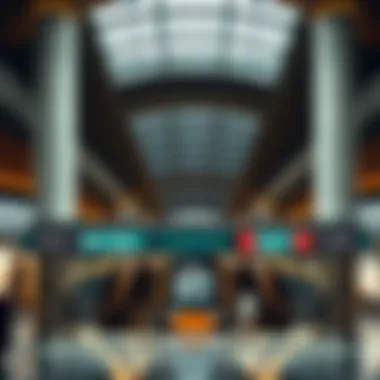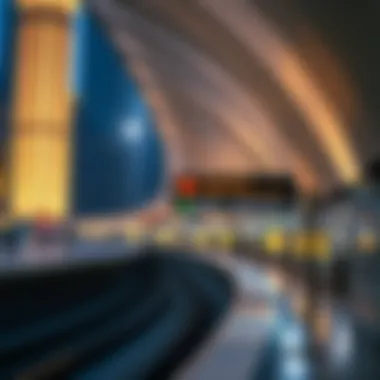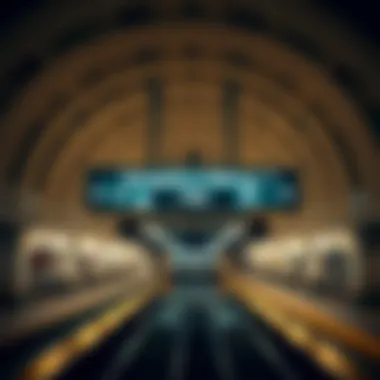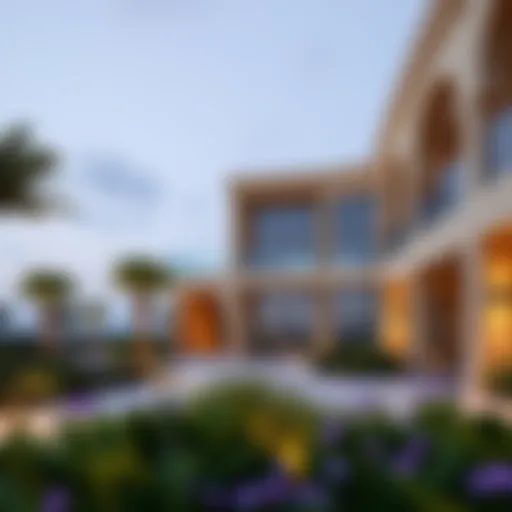Navigating Dubai's Metro Station Map: A Complete Guide


Intro
Navigating the complexities of Dubai's metro station map is not just about getting from point A to B; it's about understanding the very essence of the city's urban fabric. As one of the most rapidly developing cities in the world, Dubai's metro system plays a pivotal role in shaping the real estate landscape, connecting neighborhoods, and enhancing the daily lives of residents. This guide aims to shed light on the intricacies of the metro map, detailing how each line serves not just transportation needs, but also as a catalyst for growth and investment opportunities.
In this exploration, we will delve into the significance of each metro line, how they interlink with various districts, and the influence they hold over property dynamics. Whether you're an investor keen on tapping into emerging markets or simply someone looking to understand Dubai better, this document will navigate you through the maze of metro connections, offering insights into the evolving neighborhoods at every stop.
Investment Opportunities
Top Neighborhoods for Investment
Investing in real estate near metro stations in Dubai can be likened to planting seeds in fertile soil. Here is a selection of some neighborhoods that stand out:
- Dubai Marina: Known for its luxurious waterfront properties, it's a hub for both tourists and expatriates. The metro connects this vibrant area to the rest of the city, making it an attractive option for investors.
- Jumeirah Lake Towers (JLT): This area offers affordable apartments while still providing easy access to commercial activities. Proximity to the metro makes it appealing to both renters and homebuyers.
- Al Barsha: A lively area that has seen a steady increase in property values. The metro facilitates commuting, thus enhancing its appeal among professionals.
Upcoming Developments to Watch
As the city evolves, emerging projects are poised to change the real estate narrative significantly. Key developments include:
- Dubai Creek Harbour: This area is set to redefine urban living with access to metro facilities, promising a blend of residential and commercial properties that cater to a diverse demographic.
- Expo 2020 Site: Even beyond the expo, the site promises continued investment and growth, particularly with enhancements to public transport links.
Investors keen to stake their claim in Dubai’s ever-evolving property market must keep an eye on these burgeoning locales, as accessibility through the metro can result in lucrative returns.
Market Trends
Current Market Analysis
Presently, the real estate market in Dubai has shown resilience and adaptability amid global fluctuations. Reports indicate that properties within walking distance of metro stations have outperformed others, demonstrating the significant demand for convenient public transport options. Residential prices have stabilized in certain high-demand areas, and the trend for investors is shifting toward maximizing proximity to the metro.
Future Projections and Trends
Looking ahead, the integration of additional metro lines and expansions will likely influence housing prices and investment opportunities. The city’s thoughtful planning suggests that areas once considered peripheral will soon emerge as hotspots as they gain better connectivity through the metro. It is essential for investors to keep a close eye on developments like these, as they signify impending shifts in the market.
"Investing in properties close to metro stations is not merely a trend; it’s a strategic approach to align with the future of urban living."
By emphasizing rapid transportation access, investors can make informed decisions tailored to the dynamics of Dubai's evolving landscape. A well-placed investment today can yield significant returns tomorrow as the city's narrative continues to unfold.
Overview of Dubai's Metro System
The metro system in Dubai isn't just a means of transportation; it represents a metaphorical vein running through the city's very essence. The efficient system plays a crucial role in supporting the increasing urban population, interlinking various neighborhoods, commercial hubs, and prominent landmarks. An understanding of the metro's design and function is essential, especially for investors, agents, and property managers who need to navigate the complex real estate landscape influenced by public transport.
History and Development
Dubai's metro system embarked on its maiden voyage in September 2009, introducing a modern, reliable alternative to the city's traditional transport modes, like taxis and buses. Initially, only the Red Line was operational, but the system has since expanded, featuring both the Red and Green Lines. Over the years, rapid development followed both in infrastructure and technology.
In the early days, the metro was developed with assistance from international construction firms, enhancing not just the physical layout but also its approach to integrating advanced technology. It has since become a model of efficiency, with automated trains and smart ticketing systems, making public transport not only more accessible but also user-friendly. The metro's growth aligns with the UAE's Vision 2021, aiming to improve urban infrastructure to cater to a burgeoning populace and increasing tourism. Today, the metro system covers a vast network that continues to evolve with future expansions on the horizon.
Importance in Urban Planning
Dubai's metro extends beyond mere transportation; it plays an integral role in the city's urban planning strategies. The city's layout demonstrates a conscious effort to encourage density around metro stations, thereby reducing dependence on cars and minimizing traffic congestion. This practice fosters the development of mixed-use communities where residential, commercial, and recreational spaces exist in close proximity.
With proximity to metro stations also influencing real estate values, neighborhoods directly served by the metro are often seen as prime investment opportunities. For instance, areas around the Burj Khalifa/Dubai Mall Station are flourishing with business prospects, making them attractive for both buyers and renters. Furthermore, sustainable urban development is a key facet—by encouraging public transport, Dubai aims to lessen its carbon footprint while providing a seamless commuting experience.
"In Dubai, the metro doesn't just move people; it shapes how the city grows and thrives."
Such urban integrations are not mere happenstance but strategic positioning that enhances accessibility and convenience for residents and tourists alike. By looking at the metro's implications for urban planning, important patterns emerge that can aid savvy investors in making informed decisions as they gauge potential growth in various neighborhoods.
Understanding the Metro Map
Understanding the metro map is crucial for effectively navigating Dubai’s extensive public transportation system. It has several facets that benefit both residents and visitors alike. By familiarizing oneself with the layout, lines, and key stations, individuals can save time and make informed decisions about their travel.
The metro map is not just a collection of lines and dots. Each line connects vital parts of the city, helping commuters and tourists alike reach their destinations with greater ease. For investors and property managers, recognizing how these routes interact with residential and commercial areas can reveal much about potential growth and accessibility.
Lines and Routes


Red Line Overview
The Red Line is one of the two primary metro lines in Dubai and it runs north to south, linking many significant areas. Its contribution to the overall system cannot be overstated—it acts as the backbone, serving both the busy downtown and more residential neighborhoods. Notably, the Red Line provides direct access to major attractions like Dubai Mall and the Burj Khalifa, which makes it especially appealing for tourists.
One key characteristic of the Red Line is its extensive coverage, stretching from Rashidiya Station to UAE Exchange. This makes it a popular choice for daily commuters as well as occasional riders. However, its benefits come with challenges, such as crowding during peak hours, making it a different experience than riding at off-peak times.
Green Line Overview
The Green Line complements the Red Line by connecting areas not directly served by the other. It runs from Etisalat Station in the northeast to Dubai Marina, integrating important residential sectors into the public transit framework. Its unique feature lies in its ability to access various neighborhoods that are frequently visited by both locals and visitors.
This line significantly enhances accessibility to cultural and community centers. Additionally, given its size, it may not serve tourists’ needs as directly as the Red Line does. However, for someone looking to explore neighborhoods beyond the tourist hotspots, the Green Line is invaluable.
Future Extensions
Looking ahead, the future extensions of Dubai’s metro system promise to enhance connectivity even further. There are plans to expand both the Red and Green Lines, which will ultimately improve access to areas currently lacking direct metro service. This characteristic of ongoing improvement is appealing to urban planners and investors alike, as it opens doors to new markets and developments.
Extended lines are likely to increase property values nearby as accessibility improves and more transit options become available. While expansion will surely come with its own set of hurdles concerning construction and the need for upgraded infrastructure, the lasting implications on urban mobility are profoundly beneficial.
Key Metro Stations
Burj Khalifa/Dubai Mall Station
Burj Khalifa/Dubai Mall Station is arguably the crown jewel of Dubai's metro system due to its proximity to one of the world’s most iconic landmarks. This station serves as a conduit for thousands of visitors and locals each day, facilitating easy access to retail and dining experiences.
The convenience factor for tourists is high, with this station being strategically located by the Burj Khalifa and Dubai Mall. However, it also faces significant foot traffic, particularly during weekends and holidays, which can lead to congestion. Despite this, its designation as a key station ensures that it plays an essential role in connecting the metro to the wider Dubai experience.
Deira City Centre Station
Deira City Centre Station boasts a different flavor, serving the older, bustling part of Dubai. It’s an important stop for both shoppers and commuters. Located near a major shopping mall, it enhances consumer access to goods and entertainment.
Its characteristic strength is evident in the diverse crowd it attracts. From weekend shoppers to daily workers, Deira City Centre Station exemplifies a melting pot. However, the station's age is its double-edged sword; while it has character, some may find its facilities in need of modernization.
Dubai Marina Station
Dubai Marina Station exemplifies the luxury lifestyle associated with modern Dubai. It connects residents to the stunning coastal area, where upscale dining and leisure activities abound. Its primary characteristic is its scenic route alongside man-made waterways, making the commute an experience in itself.
Access to Dubai Marina is especially appealing for investors aiming to attract high-end clientele. Nonetheless, the station can become crowded, particularly in season when tourists flock to the marina district for leisure activities. Overall, its strategic location bolsters the appeal of the metro for those aiming to live or invest in the vicinity.
Navigating the System
Navigating the Dubai Metro system goes beyond just hopping on and off trains; it encompasses understanding the ticketing options, rider etiquette, and the operational rules of the network. For investors, agents, and property managers, mastering this system is integral. The metro not only connects key areas but also reflects the city's evolving urban landscape. An astute grasp of how to maneuver this system can lead to profitable opportunities in real estate and enhance overall commuting experiences.
Ticketing Options
The Dubai Metro offers various ticketing options that cater to different rider needs, each with its own set of features that can influence budgeting and travel frequency.
Standard Tickets
Standard tickets are the bread and butter of the Dubai Metro ticketing scheme. They allow for one-way or return trips on the metro, making them a practical choice for infrequent travelers. What makes the standard ticket standout is its simplicity. It's quite easy to purchase; riders can buy them from ticket vending machines or counters in the stations. The notable advantage is that it doesn't obligate the rider to any long-term commitments. However, the downside to these tickets is cost. For daily users, they can add up quickly, especially if you navigate multiple zones.
Monthly Passes
Monthly passes are often a hit among regular commuters. They provide unlimited travel for a fixed price, which translates to substantial savings for those who ride multiple times a week. The appealing feature is the convenience—no need to stand in line for tickets every day. However, potential users must consider that if they don’t use the metro frequently, the investment may not be wise. Notably, it includes all the metro lines, which means you can travel freely without worrying about additional costs.
Tourist Passes
For visitors, Tourist Passes offer a hassle-free way to explore the city on the metro. Valid for a designated period, usually 24, 48, or even up to 7 days, these passes allow tourists to make the most of their stay by providing unlimited access at a fixed rate. The unique charm of these passes lies in the inclusions; often they come bundled with discounts or offers for local attractions. However, somewhat ironically, tourists not familiar with their routes or frequently changing plans may find them less effective, as careful planning is necessary to maximize their benefits.
Rider Etiquette and Rules
Understanding rider etiquette and rules is essential not just for enjoying a smooth commute but also for respecting fellow passengers and maintaining order within the metro system.
Safety Regulations
Safety regulations are crucial for ensuring a secure commuting experience in the Dubai Metro. These regulations cover everything from standing behind the yellow line at platforms to proper use of escalators. They remind passengers to remain vigilant and aware of their surroundings, which is essential in crowded settings. By observing these guidelines, passengers can contribute to a safer travel environment. However, a key point of frustration can arise when individuals ignore these rules, compromising safety for everyone.


Code of Conduct
The metro's code of conduct establishes clear expectations for passenger behavior. Simple guidelines, such as giving up seats for the elderly, maintaining noise levels, and not eating on the train, help foster an agreeable atmosphere for all riders. The charm of this code is its focus on communal respect. Yet, it does come with challenges—enforcing these unwritten rules can sometimes be tricky, as not everyone shares the same understanding of personal space and courtesy. Remembering that everyone is navigating their own day can help in being more considerate toward fellow passengers.
Navigating the Dubai Metro is not just a daily task; it reflects the growth and transformation of the city itself.
Impact on Local Neighborhoods
The advent of Dubai's metro system has significantly changed the urban landscape, influencing both social dynamics and economic growth in local neighborhoods. By connecting various districts, the metro not only improves the accessibility of key locations but also plays a crucial role in shaping real estate trends and enhancing the attractiveness of certain areas for residents and investors alike.
Real Estate Trends Near Stations
Residential Developments
Residential developments near metro stations have emerged as the go-to option for homebuyers looking for convenience and accessibility. Properties in close proximity to the metro not only offer reduced travel times but also promise enhanced lifestyle options. Many of these buildings feature modern amenities, reflecting contemporary living standards. Moreover, the availability of various housing types—ranging from high-rise apartments to more affordable units—caters to a broad spectrum of potential residents.
The growing popularity of these residential areas is often linked to their affordability, combined with swift transport links to both business hubs and leisure activities. However, prospective buyers must consider possible drawbacks as well. With rapid urbanization, noise and congestion can be a concern, deterring some individuals from choosing these bustling neighborhoods as their long-term homes.
Commercial Opportunities
Similarly, commercial opportunities around these vital transport nodes have blossomed. Retail spaces, office buildings, and restaurants flourish as businesses recognize the foot traffic generated by metro users. This is particularly advantageous for those seeking to establish a presence in thriving commercial sectors, given that prime locations often guarantee higher visibility and customer engagement. However, competition is fierce, with many entrepreneurs vying for prime spots.
On the flip side, the saturation of businesses can lead to higher rents and operational costs. Thus, while commercial spaces may seem like a pot of gold, savvy investors must assess their choices carefully to avoid falling into financial pitfalls.
Accessibility and Its Benefits
Accessibility fosters a vibrant community, as it invites people from different backgrounds to mingle and participate in local activities. The ease of travel provided by the metro has transformed many neighborhoods into bustling hubs, which, in turn, draws in further investment and development.
Enhanced Connectivity
The metro's role in enhancing connectivity cannot be overlooked—it weaves together various parts of the city, making distances negligible for daily commuters. This enhancement of connectivity is an essential selling point for both current residents and newcomers alike, as it reduces dependency on private vehicles and consequently diminishes traffic congestion.
From educational institutions to healthcare facilities, the improved access allows residents to engage more fully in community life. This also leads to a more diverse populous, with families and young professionals flocking to areas that were once considered less desirable.
Attraction for Investors
Perhaps one of the most significant advantages of enhanced metro connectivity is its resonance with investors. The rise in demand for housing and commercial spaces near metro stations paints a promising picture. Investors recognize that properties near metro lines typically experience steady appreciation in value due to constant demand.
The accessibility nurtures an enthusiastic market, where buyers and renters are eager to secure a spot in the vicinity. While the returns on such investments can be attractive, potential risks, such as fluctuating market trends and changing urban regulations, must be taken into account. That said, the upward trajectory of neighborhoods linked to the metro indicates a favorable environment for those willing to navigate these challenges.
Challenges and Limitations
In any urban transit system, challenges and limitations are an inevitable part of the equation. For Dubai's metro, understanding these aspects is crucial for stakeholders, especially investors and property managers who are closely monitoring the evolution and impact of the metro's operations on the city's infrastructure and economy. By examining operational challenges, maintenance considerations, and future developments, we can paint a clearer picture of how to navigate the complexities of this impressive yet complex transportation system.
Operational Challenges
Capacity Issues
One of the paramount challenges facing Dubai's metro is capacity issues. The metro network has been designed to accommodate a significant pedestrian flow, but with the rapid growth of the city, it often finds itself at full capacity during peak times. Riders experience crowded carriages, especially in downtown areas like Burj Khalifa and Dubai Mall, creating a less than enjoyable commuting experience.
This overcrowding isn't just an inconvenience; it can deter potential users, which may impact the overall efficiency of the transit system. A unique aspect of capacity issues lies in the metro's management strategies. For example, during major events, they often roll out extra trains to mitigate bottlenecks. However, this tactic can come with increased operational costs. Thus, while measures are in place to alleviate capacity-related frustrations, they indicate that more investments are needed to enhance commuter experience and attract new riders.
Maintenance Considerations
Alongside capacity challenges, maintenance considerations emerge as another critical factor. Keeping the metro system operational demands constant attention and resources. Regular maintenance is essential to ensure safety and performance, but it can disrupt service, especially if done during peak hours. Over time, more extensive repairs can also lead to unexpected shutdowns, affecting rider trust.
The key characteristic here is a balance between proactive maintenance and minimizing the impact on riders. An interesting feature in this regard is how the Dubai Roads and Transport Authority actively engages with riders during planned maintenance works, providing real-time updates. This keeps users informed and helps manage expectations, although, in many cases, those waiting for their trains still feel the pinch of delays.
Future Developments
Looking ahead, addressing challenges isn't just about problem-solving; it's also about future developments aimed at enhancing the metro system. As Dubai evolves, so does the need for the metro to integrate technology and adopt environmental sustainability practices.
Technology Integration
Technology integration stands out as a critical aspect of future developments for the metro. Innovations such as real-time tracking apps and advanced signaling systems can significantly enhance operational efficiency. It simplifies the rider’s journey and can help mitigate capacity issues by providing accurate data on train arrivals, thus optimizing waiting times.


However, with these advancements come financial implications. Upgrading tech infrastructure requires significant investments. Still, the long-term benefits, such as increased user satisfaction and improved service reliability, outweigh initial costs, making it a viable choice for sustaining and expanding the metro’s reach.
Environmental Sustainability
Currently, environmental sustainability is becoming increasingly vital for metropolitan transit systems across the globe. For Dubai, aligning with green practices is not merely beneficial but necessary for promoting a lasting positive public perception. The metro is already a clean, efficient mode of transport compared to individual cars, but integrating more sustainable practices can amplify its role in reducing carbon footprints.
Future initiatives might include increasing energy efficiency in operations and considering renewable energy sources for powering facilities. This way, environmental sustainability serves both an ethical purpose and positions Dubai as a forward-thinking global city, potentially attracting eco-conscious investors. Yet, applying green strategies necessitates upfront expenditures that can only be justified through meticulous planning and long-term economic modeling.
"Sustainable practices are not just about saving the planet; they can also bring significant financial returns in the long run."
By grappling with operational challenges while embracing future necessary developments, Dubai’s metro not only positions itself as a transport leader but also helps accommodate the city’s growing population and its evolving needs. Investors and other stakeholders should keep a keen eye on these developments, as they are indicative of the metro's adaptability in an ever-changing urban landscape.
User Experience and Feedback
In the bustling city of Dubai, where the skyline meets innovation, the metro system often serves as a lifeline connecting people to their destinations. User experience and feedback play a crucial role in understanding how well this system meets the needs of its riders. This section explores the significance of feedback from passengers and how it impacts the overall functionality of the metro service. By embracing user experiences, the transit authorities can effectively fine-tune operations, ensuring a seamless journey for everyone.
Surveys and Data
Passenger Satisfaction
Passenger satisfaction refers to how riders feel about their overall experience using the metro. It contributes to the goal of improving the quality of service, making the metro a more attractive option for both residents and visitors. A key characteristic of passenger satisfaction is reliability; for instance, if trains arrive on time and services remain uninterrupted, people are more likely to express contentment. A beneficial factor for including passenger satisfaction surveys in this article is that they provide direct insight into the riders’ preferences.
One unique feature of measuring passenger satisfaction is the variety of metrics involved—like cleanliness of stations, frequency of service, and ease of navigation. These aspects can lead to advantages, such as improved branding for Dubai’s transit system. However, there are also disadvantages; if not managed well, negative feedback can tarnish the reputation of the metro, discouraging potential users. Therefore, recognizing and addressing these points can enhance the overall passenger experience.
Usage Patterns
Usage patterns delve into how, when, and who uses the metro most. Understanding these patterns is vital for tailoring services to meet peak demand times and optimizing resource allocation. A noted characteristic of usage patterns in urban transport systems like Dubai's is the peak-time rush, predominantly during weekdays. This pattern is a popular theme in discussions because it affects how the system is designed and operated.
One unique feature of this element is the ability to integrate technology in analyzing real-time data. By utilizing smart apps and ticketing systems, authorities can track how many people use certain routes and times, which can guide decisions on adding or reducing services. The advantage of focusing on usage patterns lies in the potential to enhance efficiency and reduce overcrowding. On the flip side, over-relying on data might overlook the nuanced needs of occasional users, which can lead to frustrations if their preferences are neglected.
Comparative Analysis with Other Cities
Public Transport Efficiency
Public transport efficiency embodies how effectively the metro system functions in transporting individuals from point A to B. It is a central point of consideration for any urban transit system, impacting everything from commuter choice to city congestion rates. A crucial characteristic of public transport efficiency in Dubai’s metro is its speed compared to surface transport, offering a reliable alternative for busy commuters. This makes it a valuable topic in any discussion about urban transit solutions.
The unique feature of this efficiency lies in its technological backbone, from automated ticket gates to real-time train tracking apps. These features collectively display the advantages of adopting a modern approach to public transport. However, challenges exist as well—such as adaptability to random surges in passenger numbers, which can sometimes lead to delays during peak hours. Hence, addressing these concerns can boost public trust in the system.
Case Studies: Global Insights
Case studies from other cities provide rich insights into the variety of challenges and successes in public transport systems. For example, cities like Singapore and Tokyo have optimized their metro systems through rigorous planning and real-time data applications. A key characteristic of these case studies is that they reveal successful strategies for urban planning and transport management.
Highlighting the unique features of varying strategies offers readers a comparative perspective. For example, Singapore’s focus on compactness and efficiency contrasts with New York City’s subway system’s more laid-back attitude towards wider coverage. While these approaches come with their benefits, they also provide disadvantages. The lessons learned can pave the way for improved strategies and innovations for Dubai’s metro system, encouraging readers to think critically about what works and what doesn’t in urban transportation.
"Understanding the user experience is not just an afterthought; it’s at the very heart of a successful metro system."
In summary, this analysis of user experience feedback and comparative efficiency highlights the importance of continual improvement and adaptation in public transport systems. For investors and stakeholders, these insights serve as a guide to navigating the complexities of Dubai's growing urban transit landscape.
Epilogue
In reflecting on the role of Dubai's metro system, it's clear that the network serves as more than just a mode of transportation; it stands at the very core of the city’s urban symphony. The metro system plays an instrumental part in streamlining traffic, reducing congestion, and enhancing overall mobility. Navigating the complexities of this system calls for an understanding of its layout, implications for real estate, and the social fabric it nurtures.
Summarizing the Metro's Role in Dubai
The metro is a lifeline for Dubai’s residents and visitors. Its efficiency has considerably shaped urban planning and development, creating a ripple effect on local businesses and communities. The Red and Green Lines connect major hubs, such as the Burj Khalifa and the Dubai Mall, providing unparalleled access to attractions that bolster the economy.
- Economic Hub: Metro stations are often strategically positioned near commercial districts, making them hot spots for investment. Businesses flourish as foot traffic increases, leading to a burgeoning retail environment.
- Real Estate Value: Properties located near metro stations typically enjoy higher demand. Investors keen on maximizing returns consider proximity to transit lines a major selling point.
- Social Connectivity: The metro not only transports people but also fosters connections across diverse neighborhoods, which can aid in breaking down barriers and enhancing community interaction.
Ultimately, the metro symbolizes Dubai's forward-thinking ethos and its commitment to creating a more accessible and integrated urban landscape.
The Future of Urban Transit in Dubai
The future appears bright for urban transit in Dubai, particularly with the metro system at the helm. As the city continues to expand, numerous advancements will likely emerge—both in terms of technological integration and in sustainability practices.
- Technology Integration: Innovations such as AI-driven scheduling, real-time tracking apps, and contactless payment methods promise to elevate the user experience. Enhancements like these would streamline operations and make commuting even more convenient.
- Environmental Sustainability: The city's future plans also emphasize green practices. By further investing in electric trains and energy-efficient stations, the metro can set an example for environmentally conscious public transport.
- Expansion Plans: Future lines and extensions will likely connect underserved areas, creating a more cohesive urban environment. This would not only ease travel but also promote economic growth in previously neglected regions.
As Dubai continues to evolve, the metro system stands ready to adapt, ensuring it remains an essential component of urban transit strategies while paving the way for a sustainable and inclusive future.
"Public transportation is the great equalizer, providing access to opportunities for all."
For more insights on urban transit, you may find these resources helpful: Encyclopedia Britannica, Wikipedia, Reddit for community discussions about navigating the city.



